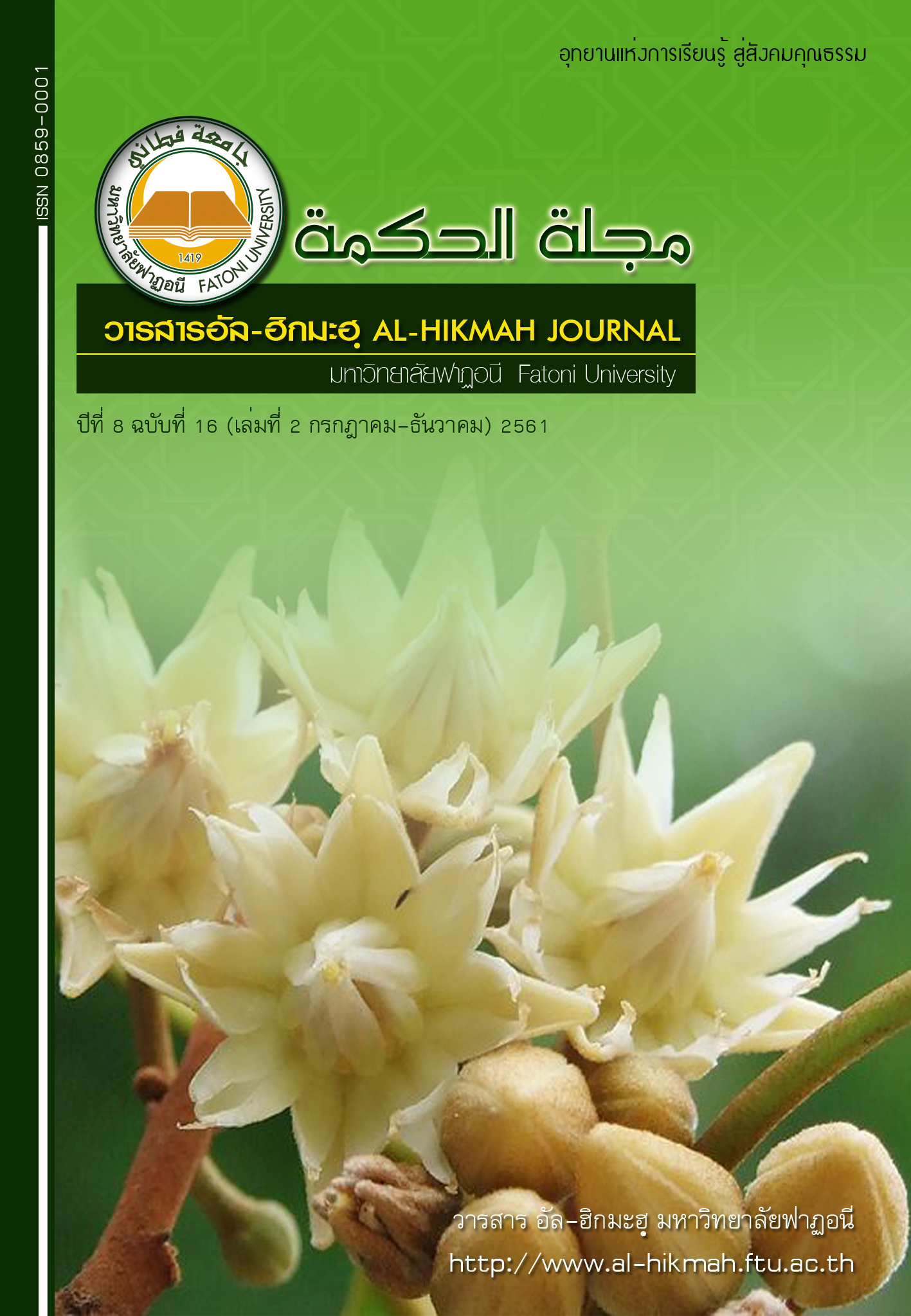ปัจจัยที่ส่งผลต่อพฤติกรรมการเป็นสมาชิกที่ดีต่อองค์การของบุคลากรในศูนย์อำนวยการบริหารจังหวัดชายแดนภาคใต้ (ศอ.บต.)
Keywords:
Organizational citizenship behavior, Organizational commitment, Organizational culture perception, Personnel in SBPACAbstract
The purpose of this research was to study 1) the level of organizational citizenship behavior, organizational commitment, organizational justice perception and organizational culture perception of personnel in Southern Border Provinces Administrative Center (SBPAC) 2) the relationship between organizational citizenship behavior, organizational commitment, organizational justice perception and organizational culture perception of personnel in SBPAC and 3) factors affecting organizational citizenship behavior of personnel in SBPAC. The samples are 238 persons of personnel in SBPAC. This research collected data by questionnaires and analyze by SPSS program which is percentage, standard deviation, Pearson correlation coefficient and stepwise multiple regression analysis. The result revealed that 1) the level of organizational citizenship behavior is highest in all dimensions. 2) The relationship between all predictive variables and criterion variables at the .01 level of significance ranged .226 - .636 which is organizational commitment, organizational justice perception and organizational culture perception and various individual variables. The correlation coefficient is ranged .543 .552 .346 .636 .361 .226 .309 .442 .474 .418 .363 .442 and .362. 3) Stepwise multiple regression analysis is divided into two part, first is in each part the result show that there are three factors that can contribute to the organizational citizenship behavior. These include normative organizational commitment (X13), organizational justice perception of interpersonal relationships (X23), and affective organizational commitment (X11). The coefficient of multiple (R) is .706 and the predictive power is 49.8%. The predictive equation can be written as a raw score and standard scores as follows:
Y = 1.952 + .129 X11 + .300 X13 + .164 X23
Z = .192 X11 + .436 X13 + .253 X23
Second is a whole part, the result show that there are two factors that can contribute to the organizational citizenship behavior. These include organizational commitment (X1) and organizational culture perception (X3). The coefficient of multiple (R) is .602 and the predictive power is 36.2%. The predictive equation can be written as a raw score and standard scores as follows:
Y = 2.366 + .283 X1 + .249 X3
Z = .438 X1 + .323 X3
References
ธีระ วีรธรรมสาธิต. (2532). ความผูกพันองค์การศึกษากรณีผู้บริหารระดับหัวหน้าแผนก/เทียบเท่าของเครือซีเมนต์ไทย. การศึกษาค้นคว้าอิสระศิลปศาสตร์มหาบัณฑิต สาขารัฐศาสตร์, มหาวิทยาลัยธรรมศาสตร์.
พรพัชรี แจ่มครุฑ. (2554). วัฒนธรรมองค์การ บรรยากาศองค์การ ลักษณะผู้นำที่มีประสิทธิภาพ และคุณภาพชีวิตในการทำงานของเจ้าหน้าที่ตำรวจสังกัดกองบัญชาการตำรวจนครบาลท้องที่เกาะรัตนโกสินทร์. วิทยานิพนธ์ปริญญามหาบัณฑิต,คณะศิลปศาสตร์, สาขาวิชาจิตวิทยาอุตสาหกรรมและองค์การ มหาวิทยาลัยธรรมศาสตร์.
รัตนา เลี้ยงพาณิชย์. (2556). ปัจจัยทีมีอิทธิพลต่อพฤติกรรมการเป็นสมาชิกที่ดีต่อองค์การของพนักงานระดับปฏิบัติการของสำนักงานคณะกรรมการเลือกตั้ง. มหาวิทยาลัยเกษตรศาสตร์.
วรพงษ์ รวิรัฐ. (2546). การวางแผนทรัพยากรมนุษย์. กรุงเทพฯ: สมาคมการจัดการงานบุคคลแห่งประเทศไทย.
ศูนย์อำนวยการบริหารจังหวัดชายแดนภาคใต้. (2560). ประวัติความเป็นมา. สืบค้นเมื่อ 20 พ.ย. 2560 จาก http://www.sbpac.go.th/index
สิริรัตน์ พงษ์สงวน. (2550). ความสัมพันธ์ระหว่างคุณลักษณะของงาน ความผูกพันต่อองค์การ ความเชื่อในปัจจัยควบคุมและพฤติกรรมการเป็นสมาชิกที่ดีต่อองค์การ. มหาวิทยาลัยเชียงใหม่.
Babcock-Roberson, M. E., & Strickland, O. J. (2010). The relationship between charismatic leadership, work engagement, and organizational citizenship behaviors. The Journal of Psychology, 144(3), 313-326.
Folger, R. & Cropanzano, R. (1998). Organizational Justice and Human Resource Management. California: Sage.
Krejcie, R. V., & Morgan, D.W. (1970). Determining sample size for research activities. Educational and Psychological Measurement, 30 (3), 607-610.
Organ, D. W. (1987). Organizational Citizenship Behavior: The good soldier syndrome. Massachusetts: Health & Company.
Organ, D. W. (1988). Organizational Citizenship Behavior: The Good Soldier Syndrome. Lexington, Massachusetts: Lexington. Books.
Robbins, S. P. (1991). Organizational Behavior: Concepts, Controversies, and Applications (5th ed.). New Jersey: Prentice-Hall.
Sheldon, Mary E. (1971). Investment and Involvement as Machanism Producing Commitment to the Organization. s.n. : Administrative Science Quarterly.



